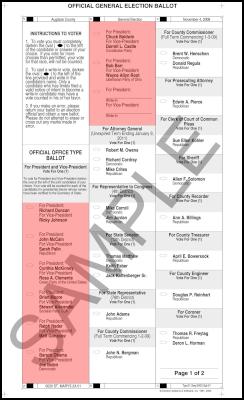Potential Ballot Trouble In OH: Split Contests
Potential Ballot Trouble In OH: Split
Contests
The twelve Ohio counties whose ballots spilt the presidential race over two columns are: Ashtabula, Athens, Auglaize, Champaign, Delaware, Lawrence, Logan, Madison, Ottawa, Seneca, Shelby, and Wyandot.
As a quick glance will show, it's no surprise that many voters cast two votes for president when the contest is listed across two separate columns. The one below is from Auglaize County (click to see larger).

Click to enlarge
In July, the Brennan Center published Better Ballots, a study of ballot design flaws in the last several elections and their impact on those elections. The study showed that ballots that featured a single contest split into two columns, as seen in the illustration of Auglaize County's ballot above, frequently confused voters. A split contest like this is often seen by voters as indicating two separate tasks (i.e., vote once in each box) and can lead to unintentional overvoting.
In 2002, in Kewaunee County, Wisconsin, for example, the ballot listed the candidates for the gubernatorial election in two columns. Nearly 12% of voters in the county did not have a vote counted in the race; this compares to only 1.1% of voters statewide. The low number of votes recorded in the gubernatorial election in Kewaunee County was undoubtedly because many voters believed the governor's race was actually two races, and voted twice in that race—once for one of the candidates boxed in together in the first column, and once again for one of the candidates boxed in the second column. As a result, none of their votes for Governor counted.
The Brennan Center and the United States Election Assistance Commission have issued ballot design guidelines strongly recommending that a single contest be placed in a single column on a ballot. For the Ohio counties with split presidential columns, the Brennan Center urges election officials and advocates to make sure that voters are aware of the split, and to make sure voters vote only once for president.
Hundreds of thousands of voters have been disenfranchised in recent elections due to badly designed ballots and confusing voting instructions—particularly elderly, low-income and new voters.
To see the Brennan Center's ballot design study, Better Ballots, and read more about how specific ballot design flaws continue to plague voters in 2008, visit the Brennan Centers' interactive demonstration here.
Mr. Norden is the project director for the Voting Technology Assessment Project. As Counsel at the Brennan Center, Mr. Norden works in the areas of voting systems, voting rights and government accountability. In addition to these responsibilities, he edits and writes for the Brennan Center's blog on New York State, ReformNY. Mr. Norden is the lead author of The Machinery of Democracy: Protecting Elections in an Electronic World (Academy Chicago Press) and a contributor to the Encyclopedia of American Civil Liberties (Routledge 2007). He is a graduate of the University of Chicago and New York University School of Law. Before joining the Brennan Center, Mr. Norden was in private practice, concentrating in commerical litigation, technology and bankruptcy law. lawrence.norden@nyu.edu


 Binoy Kampmark: Fallibility, Dirty Wars And Pope Francis I
Binoy Kampmark: Fallibility, Dirty Wars And Pope Francis I Peter Dunne: Dunne's Weekly - An Issue No-one Can Afford To Lose
Peter Dunne: Dunne's Weekly - An Issue No-one Can Afford To Lose Martin LeFevre - Meditations: Choosing Mass Murder?
Martin LeFevre - Meditations: Choosing Mass Murder? Eugene Doyle: Quiet Mutiny - The U.S. Army Falls Apart
Eugene Doyle: Quiet Mutiny - The U.S. Army Falls Apart Gordon Campbell: Papal Picks, And India As A Defence Ally
Gordon Campbell: Papal Picks, And India As A Defence Ally Binoy Kampmark: The Selling Of America - Ending The US Dollar’s Exorbitant Privilege
Binoy Kampmark: The Selling Of America - Ending The US Dollar’s Exorbitant Privilege